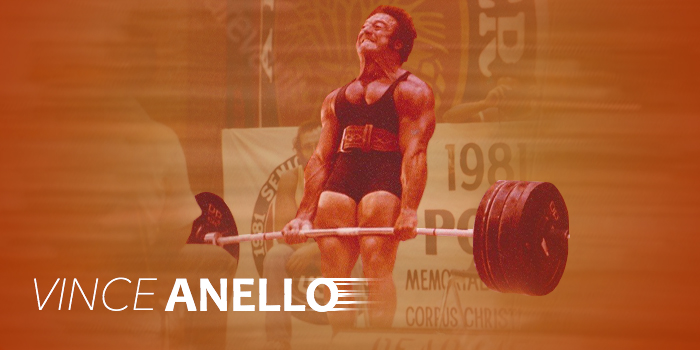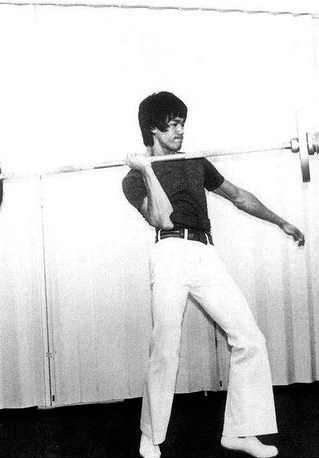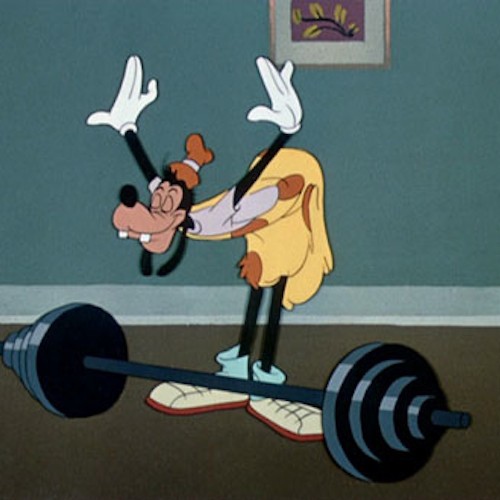HIGH INTENSITY TRAINING FOR BODYFAT LOSS:
Why Aerobic Training and Powerlifting Don't Mix
by Rick Brunner (1996)
A powerlifter pumps away on a stationary bike for half and hour with the goal of shedding those extra fat pounds to stay in a lower weight class. Day after day, week after week he peddles, steps and jogs his way toward leanness. The trouble is, as he gets lean, not only does he lose some fat, but he loses muscle and strength. Aerobic training of any kind takes away from powerlifting training.
The scientific research is conclusive. Aerobic training is not the answer for fat loss in power related sports. This goes against traditional thinking, but it's scientific fact. When it comes to fat loss for powerlifting, high intensity training (HIT), or what I call High Tension Training, beats out endurance training.
In my opinion, a powerlifter should never perform pure aerobic training, even if they need to drop bodyfat. HIT is the answer to bodyfat loss and muscle gain as it leads to a better fat utilization in the post-exercise state, contributes to a greater energy and fat deficit and stimulates additional muscle protein biosynthesis.
Drug-free powerlifting, especially at the advanced level, is not easy. The muscles must continuously adapt to heavier and heavier loads (a greater percent of maximum) to build additional muscle proteins through the processes of hypertrophy and hyperplasia. Recent research has shown that anaerobic training is far more effective at reducing bodyfat than is aerobic training [Bahr 1991, and Tremblay 1990 and 1994]. During the workout, aerobic type training does burn more bodyfat than does high intensity training, but in post-exercise recovery high intensity training beats aerobic training hands down.
The decrease in bodyfat relative to the energy cost of training can be ninefold greater in high intensity trained persons than it is in endurance trained persons. [Tremblay, 1994]
What this means is that by training with high intensity methods you can burn several times more fat in recovery than than if you train using aerobic methods, plus you will build more muscle [Grediagin, 1995], which itself will burn more fat. You will become a walking fat burner, not as much during the workout, but after training when you go about your daily life. An added benefit is that anaerobic training requires much less time to perform.
My experience in leaning out powerlifters is a multi-directional approach. I never look to fat loss as the only goal in a training cycle because time is valuable and every second you spend on the fat issue takes away from building dense muscle and strength. A multi-directional approach to both fat loss and muscle gain calls on several components of training.
The three most important components are training program design, base diet, and supplements. You are going to be training with high intensity and you need to recover optimally from this intensity. [During the time of this article Rick Brunner was involved heavily with Atletika Sports Nutrition. Good to know these things when reading any lifting or bodybuilding article, as well as 'help' on any forum. Quite often you'll find, regardless of how up front or subtle or how buried the intent may be, a connection between the desire to sell something, even if it's a coaching approach, and the author. Know what to take away and what to leave behind. Wheat and chaff.]
Training Program Design
The training must stress the muscle in a way which will cause it to adapt and grow raising the metabolic at the same time. High intensity training must create a tension on the muscle which will cause the neuroendocrine system to signal the release of additional testosterone and growth hormone. It is not just training with high reps to failure.
To lose a significant amount of body fat at the same time you build muscle mass, you must modify your training plan. You'll need to increase your exercise heart rate to a high anaerobic level. This exercise heart rate should be between 80% and 90% of your maximum heart rate. A simple way to calculate maximum heart rate is 220 minus your age.
Okay, no matter how old you are or how tiresome your 'jokes' you must elevate your heart rate during exercise to the anaerobic intensity level. In recovery, once your heart rate drops to around 105 to 115 beats per minute you should begin a new set to again raise the rate.
I have listed two timed set methodics which can be used with any exercise. This methodic reads:
-- "As many reps as you can perform in a given time."
For example, 30s means as many reps as you can perform in 30 seconds.
-- The number of sets.
-- % of One Rep Maximum for that exercise.
-- Rest between each set. For example, 2m is two minutes rest.
For each exercise, once you complete the first methodic you move on to the next one until you complete each one. Then you move on to the next exercise. Still not sure why I used that term methodic, though. I suggest about three exercises per workout.
The methodics I have listed are by no means the only ones you can use. The key is to create the right amount of tension on the muscle for a certain time to stimulate the high heart rate (the goal). If you aren't getting your heart rate to the target level raise the tension (% of maximum), increase the time of work, and/or reduce the rest period between sets. You can increase the intensity and/or your volume as needed to reach your target rate.
The exercise you use should be basic ones.
No reverse wrist curls, sir. Stick with exercises like flat bench press, squat, power cleans, high pulls, rows, pulldowns, presses, clean and presses, etc. Begin each workout with a major muscle group exercise such as squat or power clean as they will set your metabolism in a full out fat burner.
Training Methodics
Examples -
Intermediate:
20s, 3, 83-87%, 2m
(as many reps as possible in 20 seconds, 3 sets, 83-87% of 1RM, 2 minutes rest between sets)
20s, 3, 72-78%, 1m
10s, 2-3, 40-50%, 30 seconds
Advanced:
30s, 4, 87-95%, 2m
20s, 4, 78-83%, 1m
10s, 2-4, 44-55%, 30 seconds
The three most important components are training program design, base diet, and supplements. You are going to be training with high intensity and you need to recover optimally from this intensity. [During the time of this article Rick Brunner was involved heavily with Atletika Sports Nutrition. Good to know these things when reading any lifting or bodybuilding article, as well as 'help' on any forum. Quite often you'll find, regardless of how up front or subtle or how buried the intent may be, a connection between the desire to sell something, even if it's a coaching approach, and the author. Know what to take away and what to leave behind. Wheat and chaff.]
Training Program Design
The training must stress the muscle in a way which will cause it to adapt and grow raising the metabolic at the same time. High intensity training must create a tension on the muscle which will cause the neuroendocrine system to signal the release of additional testosterone and growth hormone. It is not just training with high reps to failure.
To lose a significant amount of body fat at the same time you build muscle mass, you must modify your training plan. You'll need to increase your exercise heart rate to a high anaerobic level. This exercise heart rate should be between 80% and 90% of your maximum heart rate. A simple way to calculate maximum heart rate is 220 minus your age.
Okay, no matter how old you are or how tiresome your 'jokes' you must elevate your heart rate during exercise to the anaerobic intensity level. In recovery, once your heart rate drops to around 105 to 115 beats per minute you should begin a new set to again raise the rate.
I have listed two timed set methodics which can be used with any exercise. This methodic reads:
-- "As many reps as you can perform in a given time."
For example, 30s means as many reps as you can perform in 30 seconds.
-- The number of sets.
-- % of One Rep Maximum for that exercise.
-- Rest between each set. For example, 2m is two minutes rest.
For each exercise, once you complete the first methodic you move on to the next one until you complete each one. Then you move on to the next exercise. Still not sure why I used that term methodic, though. I suggest about three exercises per workout.
The methodics I have listed are by no means the only ones you can use. The key is to create the right amount of tension on the muscle for a certain time to stimulate the high heart rate (the goal). If you aren't getting your heart rate to the target level raise the tension (% of maximum), increase the time of work, and/or reduce the rest period between sets. You can increase the intensity and/or your volume as needed to reach your target rate.
The exercise you use should be basic ones.
No reverse wrist curls, sir. Stick with exercises like flat bench press, squat, power cleans, high pulls, rows, pulldowns, presses, clean and presses, etc. Begin each workout with a major muscle group exercise such as squat or power clean as they will set your metabolism in a full out fat burner.
Training Methodics
Examples -
Intermediate:
20s, 3, 83-87%, 2m
(as many reps as possible in 20 seconds, 3 sets, 83-87% of 1RM, 2 minutes rest between sets)
20s, 3, 72-78%, 1m
10s, 2-3, 40-50%, 30 seconds
Advanced:
30s, 4, 87-95%, 2m
20s, 4, 78-83%, 1m
10s, 2-4, 44-55%, 30 seconds
















